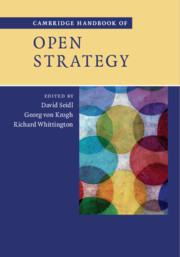Book contents
- Cambridge Handbook of Open Strategy
- Cambridge Handbook of Open Strategy
- Copyright page
- Contents
- Figures
- Tables
- Introduction
- Part I The Concept of Open Strategy
- Part II Practices of Open Strategy
- Part III Technological Assemblages for Open Strategy
- Part IV Theoretical Perspectives
- Chapter 13 Practice-Theoretical Perspectives on Open Strategy: Implications of a Strong Programme
- Chapter 14 A Sensemaking Perspective on Open Strategy
- Chapter 15 A Dialogic Perspective on Open Strategy
- Chapter 16 A Social Network Perspective on Open Strategy
- Chapter 17 An Institutional Perspective on Open Strategy: Strategy in World Society
- Part V Challenges of Open Strategy
- Index
- References
Chapter 15 - A Dialogic Perspective on Open Strategy
from Part IV - Theoretical Perspectives
Published online by Cambridge University Press: 13 July 2019
- Cambridge Handbook of Open Strategy
- Cambridge Handbook of Open Strategy
- Copyright page
- Contents
- Figures
- Tables
- Introduction
- Part I The Concept of Open Strategy
- Part II Practices of Open Strategy
- Part III Technological Assemblages for Open Strategy
- Part IV Theoretical Perspectives
- Chapter 13 Practice-Theoretical Perspectives on Open Strategy: Implications of a Strong Programme
- Chapter 14 A Sensemaking Perspective on Open Strategy
- Chapter 15 A Dialogic Perspective on Open Strategy
- Chapter 16 A Social Network Perspective on Open Strategy
- Chapter 17 An Institutional Perspective on Open Strategy: Strategy in World Society
- Part V Challenges of Open Strategy
- Index
- References
Summary
Open Strategy is a process that engages internal and external stakeholders in various degrees of transparency and inclusion (Whittington et al., 2011). It presupposes at minimum episodic information transfer among the parties involved, and for more meaningful inclusion, continuing dialogue (Heracleous et al., 2018). Dialogue, as an ongoing process of communication among actors who pursue a particular goal or set of goals, is integral to Open Strategy processes. As a way of linking an organization with its stakeholders, an effective dialogic process can provide generative diversity to the ideas that inform strategy and contribute to a strategic direction that has stakeholder and market relevance. There are costs, however, as dialogue can also fuel the undesirable side of the dilemmas outlined by Hautz, Seidl, and Whittington (2017) and various types of tensions noted by other authors (e.g., Baptista et al., 2017; Heracleous et al., 2018). Ongoing dialogue with little hierarchical, ideational, or temporal constraints, for example, can lead to conflict, inefficient decision making, wasteful use of resources, and pursuit of personal agendas, as pointed out by the dilemma of process (Hautz et al., 2017) and illustrated by ethnographies of a dialogical organization par excellence, Wikimedia (Jemielniak, 2014, 2016).
- Type
- Chapter
- Information
- Cambridge Handbook of Open Strategy , pp. 259 - 271Publisher: Cambridge University PressPrint publication year: 2019
References
References
- 5
- Cited by



